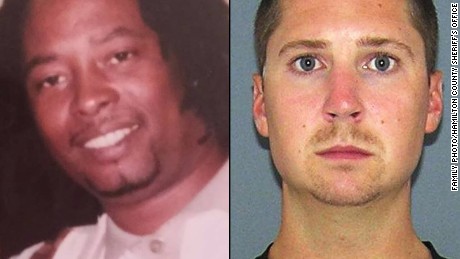
Authorities in Ohio said Tuesday that they would make another attempt at trying a former police officer who shot and killed an unarmed black man during a traffic stop in Cincinnati last year.
A judge had declared a mistrial earlier this month in the first prosecution of former University of Cincinnati officer Raymond Tensing, saying that the jury was deadlocked after deliberations.
Hamilton County prosecutor Joseph Deters, who was sharply critical of Tensing when the officer was charged with murder and manslaughter last year, said Tuesday that he had made the decision to retry Tensing for the death of Samuel DuBose.
“This decision was made after review of the trial transcript, discussion with some of the jurors, and consultation with my staff,” Deters said in a statement. “I am hopeful that a second jury will be able to reach a decision to bring justice in this case for the victim’s family and our community.”
After the mistrial was declared earlier this month, Deters said that jurors were leaning toward convicting Tensing of voluntary manslaughter, a lesser charge, and acquitting him on the murder charge. Ultimately, the jurors were unable to reach a unanimous verdict in the case.
A spokeswoman for Deters confirmed to The Washington Post that he intended to prosecute Tensing again on the murder and manslaughter charges. If convicted, Tensing could face up to life in prison.
An attorney for Tensing did not immediately respond to a request for comment Tuesday. He had previously told the Cincinnati Enquirer he hoped the case did not go to a second trial, saying that if it did, “you probably end up with a similar result.”
Tensing had stopped DuBose during an off-campus traffic stop in July 2015 for failing to display his front license plate. Tensing had said he was forced to shoot DuBose during the encounter because he was being dragged by the car, according to the initial police report.
But video footage captured by the officer’s body camera showed that Tensing appeared to thrust the gun into the car and fire after DuBose had started the engine but while the car was still standing still.
Deters had assailed Tensing for the killing, describing it as a “senseless, asinine shooting” during a news conference on the day the officer was charged.
“It was so unnecessary for this to occur,” Deters said at the news conference. His office had reviewed more than 100 police shootings by that point, Deters said, and the DuBose killing was “the first time that we’ve thought, ‘This is without question a murder.'”
DuBose was one of 991 people fatally shot by police last year, according to The Washington Post’s database tracking these shootings.
Officers who shoot people in the line of duty are rarely charged, but that number has increased in recent years during intense nationwide scrutiny on how police officers use force. Video footage has increasingly been a factor in shootings that lead to charges.
Between 2005 and 2014, 48 officers were charged for shootings, according to Philip M. Stinson, a criminologist at Bowling Green State University in Ohio who studies arrests of officers.
Tensing is one of 30 officers who have been charged with murder or manslaughter for an on-duty shooting since the beginning of 2015.
During the trial, prosecutors revealed that during the shooting, Tensing, a white police officer, was wearing a T-shirt with a Confederate battle flag on it. Cincinnati had been the site of riots, looting and protests after a white officer killed an unarmed black man in 2001, which prompted a Justice Department review of the city’s police force and a series of reforms.
The University of Cincinnati said earlier this year it would pay $4.85 million to DuBose’s family in a settlement.
Last week, prosecutors in Minnesota said they were charging a police officer in a Twin Cities suburb with second-degree manslaughter for fatally shooting a man during a July traffic stop there. The prosecutor who announced the charges said he opted for second-degree manslaughter, rather than a first-degree or murder charge, because he believed it was “the highest, most provable offense.”
(c) 2016, The Washington Post · Mark Berman

